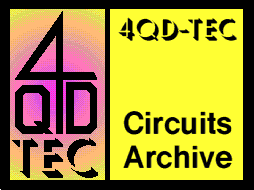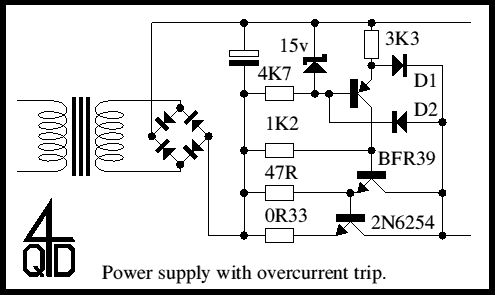

|
4QD-TEC
|
|
Here's a circuit for a relatively simple regulated power supply which has well controlled characteristics, including a clever over-current trip.

The 15v zener is fed via the 4K7 resistor from the input. With 0.6v across the base - emitter of the PNP transistor, this establishes a voltage of 14.4 across the 3K3, so there must be a current of nearly 4.4mA through the 3K3. This current is available to feed the emitter of the transistor - provided that the diode D1 doesn't pinch any of it. However with no load on the output, some of this current flows through the PNP to turn on the BFR39 and the 2N6254 which will conduct. As there is no load, the only place the power transistor can get any current through D1 so it will pinch enough current so that what remains of the 4.4 mA is only just enough to keep it working.
Since there is 14.4v across the 3K3 and about 0.6v across the diode there will be 15v present across the output. If the output is loaded the voltage drops by a fraction - this reduces the diode current, allowing more current to flow into the output pair to keep the output voltage up.
When the output pair is using all the available 4.4mA there will be no current through the diode so any extra load will cause the output voltage to drop. If it drops by 1.2 volt (two diode drops) the second diode will start to conduct. This pinches current from the 15z v zener so its voltage reduces, reducing in turn the current through the 3K3 thus reducing the drive to the output so the output collapses - the supply has tripped off. However it is not quite off: even with the output shorted out a tiny current flows in the PNP so that the circuit will reset when the load is removed.
To alter the output voltage - chose a different zener voltage. This will alter the current available to the PNP so you will have to alter the 3K3.
The output pair is heavily defined with resistors to limit the current it will give at a base drive of 4.4mA. The values shown cause it to 'run out of steam' at around 3 amps. Reducing the 0R33 (330 milliohms) will increase this current as will reducing the 3K3 or increasing the 1K2. The values shown were chosen to swamp the anticipated variations in transistor gains so a production run would be adequately repeatable. You can also parallel several power transistors: connect the base together and use a separate emitter resistor for each.
The circuit is quite simple so it not a high performance supply: the output voltage will rise and fall a little with current because of the slight variation of voltage across D1 as the current through it alters. Also the current feed to the zener is straight off the input so the slope resistance of the zener will cause variation with load and a little ripple on the output. Nevertheless the circuit has a good performance for such a simple circuit.
Remember that power transistors get hot: with 20 volt input and 15 out the transistor will dissipate (20-15)x3 watts - 15 watts, which is not a huge amount, but with a current limit and the output shorted this would rise to 60 watts! The re-entrant current limit as here reduces the shorted power dissipation a lot. There is a point you will need to watch. If at 2 volts output the supply only delivers say 50mA this is fine - as long as the load doesn't take 50mA at 2v. If it does, the supply will never turn on!
Also in preparation are details of a full laboratory type power supply with fully adjustable current limiting and output voltage. This can be used to make, maybe, 0-50v at 0-5 A, or other ranges as the builder may require.
| 4QD Sites: |